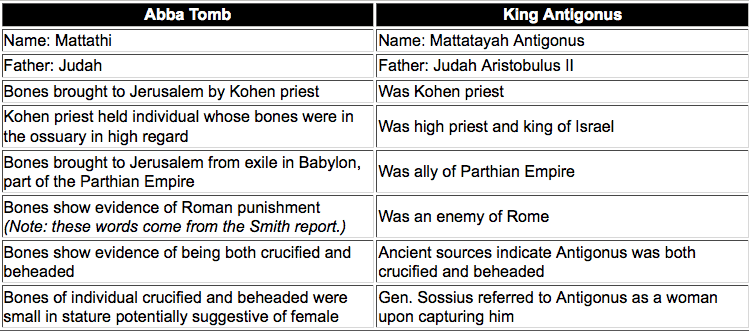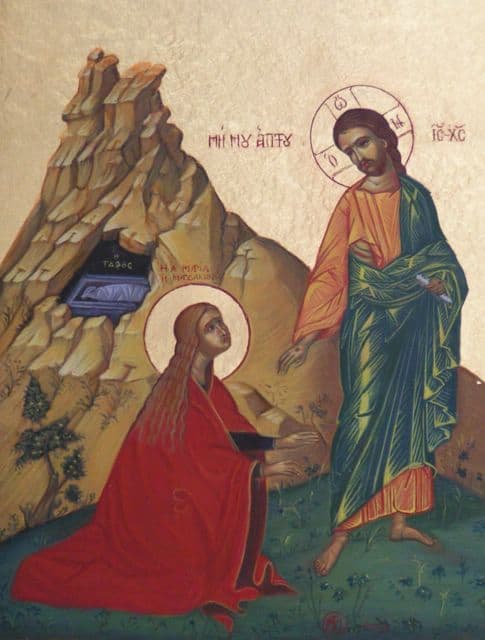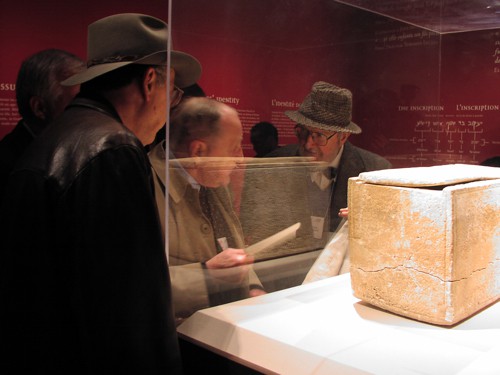The mystery deepens…the plot thickens…

Few have heard anything about the “Abba Cave,” discovered in 1971 in the north Jerusalem suburb of Givat Hamivtar–not far from the tomb of “Yehohanan,” the famous “crucified man,” discovered in 1968–about which much has been written. The Abba cave held the remains of another “crucified man,” with three nails–not just a single one in the heel bone–that clearly pinned the hands (not the wrists, as some have argued) in hook-like fashion to a cross beam. It was assumed back in the 1970s that these bones were buried and no longer available for analysis–but it turns out this is not the case. What is even more intriguing, the victim was arguably none other than Matitiyahu Antigonus–the last of the Hashmonean kings–who was both beheaded and crucified by Marc Anthony. in 37 BCE).
And even more significant, Greg Doudna has persuasively argued that this Antigonus is in the thick of things reflected in the Dead Sea Scrolls with the various priestly figures vying for power. Doudna identifies Hyrcanus II, the great opponent of Antigonus, as none other than the famed “Teacher of Righteousness” in the Dead Sea Scrolls, see a summary of his evidence, “A Narrative Argument that the Teacher of Righteousness was Hyrcanus II.”
Here is an overview and an update on the discovery, published in HaAretz:
Cold case: Did archaeologists find the last Maccabean king, after all?
Crucified remains and a broken jaw have confused scientists for decades. But it could well be that the last Hasmonean king has been found under a private house in Jerusalem.
By Ariel David, Apr. 29, 2014
In 1970, a rock-cut tomb was discovered by workers building a private house in Jerusalem’s Givat Hamivtar neighborhood. Inside the two-chambered burial, dating back to the first century BCE, archeologists found a decorated ossuary – a limestone box containing the bones of the deceased – and an enigmatic Aramaic inscription affixed to the wall.
“I am Abba, son of Eleazar the priest,” proclaimed the 2,000-year-old text. “I am Abba, the oppressed, the persecuted, born in Jerusalem and exiled to Babylon, who brought back Mattathiah son of Judah and buried him in the cave that I purchased.”
Who was Abba, this unfortunate priest from Jerusalem? And who was the Mattathiah whose remains were apparently buried in the cave?
These questions have been fiercely debated by scholars for the past 40 years. Now. new research indicates that the initial interpretation of the find, that has long been dismissed, may have been right all along. This view identifies the Abba cave as the final resting place of a key figure in Jewish history: Mattathiah Antigonus II, the last king of the Hasmonean dynasty, whose reign was followed by Roman conquest, the destruction of the Second Temple and two millennia of exile.
A secret burial?
The supposed discovery of his remains was widely publicized in the Israeli media in the 1970s, and set off an archeological detective story that continues to this day, punctuated by academic rows, sudden tragedies and surprising twists.
Historians initially came up with the Antigonus II theory based on the names on the inscription and the tomb’s unusual features. Abba’s boastful claim and the painstakingly decorated ossuary, considered by archeologists one of the finest ever found, pointed to an important personage.
At the same time, the cryptic text, the fact that the ossuary lacked any identifying inscription and that it was found buried in a niche under the floor of the cave suggested that Abba may have acted in secret, which is consistent with the persecution the Hasmoneans and their followers suffered after the fall of Mattathiah.
The Maccabees, or Hasmoneans, had ruled ancient Israel since leading the revolt against the Syrian Greeks, which Jews commemorate during Hanukkah. The young Mattathiah, son of King Judah Aristobulus II, ruled only for three years. His reign was marked by constant warfare to keep Judea out of the clutches of Rome and its main ally in the area, Herod.
In 37 BCE, Herod seized Jerusalem and the throne. Mattathiah was captured, taken to Antioch and executed by Marc Antony, who at the time ruled Rome’s Eastern provinces with his lover, Cleopatra.
Horrific death
The theory that Abba may have retrieved the Hasmonean king’s body from Antioch, today in southern Turkey, and secretly buried it in his family tomb received a boost in 1974, when Nicu Haas, Israel’s top physical anthropologist at the time, discussed his analysis of the bones found inside the ossuary on Israeli television.
Interviewed for a program titled “The Last of the Maccabees,” Haas said he had identified the bones of at least two individuals, one older and one a young adult, around the age of 25, who had suffered a horrific death. Three nails where found in the ossuary with pieces of hand bones attached to two of them, suggesting the victim had been crucified.
Haas also identified clean cuts on the man’s second vertebra and lower jaw, indicating he had been decapitated with a sword or other sharp object. These findings were consistent with Mattathiah’s age and with the account of his execution given by ancient historians Josephus Flavius and Dio Cassius who recount that Marc Antony had the king crucified, scourged and beheaded.
With Haas’ analysis, all the pieces of the puzzle seemed to fall into place. But then, there was an accident. A month after the TV program aired, Haas slipped on an icy Jerusalem street and hit his head. He spent the last 13 years of his life in a coma and never published his findings on the cave.
The bones were passed on for analysis to Patricia Smith, an anthropologist from the Hebrew University. While agreeing that the remains included the skull fragments of a young man, she concluded that the cut jaw belonged to the elderly person – and that this individual was a woman. In her report, published in 1977 in the Israel Exploration Journal, she also dismissed the idea that crucifixion had occurred because the nails had not passed through the bones.
The Hasmonean thesis dies, mostly…
Based on Smith’s analysis, the Hasmonean hypothesis was abandoned and the investigation into the Abba cave was closed. The ossuary and the inscription were given to the Israel Museum, where they are still displayed today, and the bones, following pressure from ultra-orthodox Jews were reburied in the same spot they were found.
But not everybody accepted that Abba’s riddle could not be cracked.
Raphael Delarosa, the owner of the house under which the cave was found, continued to believe that he was living above the tomb of the last true king of Israel.
“There was a beautiful ossuary and an inscription describing the people buried here, clearly this was someone important,” Delarosa told Haaretz. “I felt a piece of Jewish history had been placed on my shoulders and I had to save it.”
Delarosa preserved the cave and kept it open for small groups of visitors and researchers. Recently, new scholarly work and evidence has emerged that supports the original hypothesis and casts doubt on the skeptics’ position.
In a paper published last year in the IEJ, Yoel Elitzur, a Hebrew University historian, sheds some light on the enigmatic priest Abba and links him to the Hasmonean dynasty.
As a scholar of Semitic languages and of the names of places in ancient Israel, Elitzur notes that in Jewish texts and manuscripts the name Abba and Baba were often used interchangeably. He identifies Abba as the head of a family mentioned by Josephus as the “the sons of Baba” and described as being supporters of the Hasmoneans long after Herod had taken power.
Elitzur also speculates that following Haas’ accident, Smith may have received a disorganized mix of bones including remains from other sites, leading to a possible mistake in identifying the person with the cut jaw as a female.
“Here we have the two top anthropologists in the country saying opposite things; they can’t be both right,” Elitzur said in a telephone interview. “Given that Haas received the bones fresh from the dig and not after they sat for years in a lab, I tend to go with his interpretation.”
Contacted by Haaretz, Smith said in an email that a mix-up “was possible but unlikely.”
She wrote that while the absence of the pelvis and complete skull made gender identification difficult, she was convinced the mandible belonged to a woman “based on its condition, size, shape and pathology.” Smith added that two of her colleagues had seen the bones and agreed with her findings.
Case closed – again? Not so fast.
Was it a man after all?
In yet another twist of this puzzling cold case, Haaretz can reveal that researchers did not return all the bones for reburial in the cave.
Some key remains, including the nails and the cut jaw and vertebra, were sent for safekeeping to Tel Aviv University anthropologist Israel Hershkovitz and remained untouched in his lab for years.
After reading Elitzur’s paper, Hershkovitz re-examined the remains. He analyzed the nails using an electron microscope, determining that they did break the bones of the hand, as would occur in crucifixion. This itself is a blow to skeptics, since Romans rarely crucified women, Hershkovitz said.
He also doubts Smith’s finding that the time-worn jaw belonged to a woman.
“Only the pelvis and the skull can give an indication of a skeleton’s sex, it’s impossible to scientifically determine it from a jaw bone, especially when it is severely fragmented,” Hershkovitz told Haaretz. “Actually the size and shape look more like that of a male to me, but it’s just a feeling, there is no scientific basis for it.”
Hershkovitz has been trying to extract DNA from the jaw in order to confirm whether it belonged to a man or a woman. Though that would not confirm Mattathiah’s identity, it would give weight to all the other evidence that points to him, he said.
“Once you remove the idea that the cut mandible belonged to a woman, you are left with all the other elements that prove that this is Mattathiah,” he said. “In this case, the writing was literally on the wall.”
Despite recent nay-saying, (see Doudna’s comments at the Zias article) by those who are apparently not aware of all the facts, including the available skeletal remains and nails mentioned here, the case that the tomb held the remains of a crucified/beheaded male, as Nicu Haas first indicated, is a convincing one, given this latest analysis from Prof. Hershkovitz. Also those who have argued that crucifixion nails went through the wrist not the hands, and that these nails are too “short” to be for crucifixion, are just mistaken. Hershkovitz has definitely clarified this issue. The nails are driven into the palm, then either angled or bent into a hook, not to hold up the body but to keep the hands and arms in place–thus “tacking” or pinning the hands to the wood behind. The hypothesis that this individual was the Hasmonean royal priest/king Antigonus turns out to be a live option.
In 1946, the year I was born, Robert Graves published his novel King Jesus, in which he argued that Jesus of Nazareth was the paternal grandson of Herod the Great through Herod’s son Antipater, whom Herod murdered five days before his death, as well as the maternal grandson of King Antigonus, the last Hasmonean king, since Antipater’s royal wife Mariame (Jesus’ mother) was a daughter of Antigonus, and was pregnant at his death. Joseph Raymond has vastly fleshed out and expanded the thesis in his book, Herodian Messiah and a subsequent novel titled: Grandson of Herod: IESVS NAZARENVS REX IVDAEORVM. Raymond proposes that Mariame and the infant Jesus escaped to Egypt despite Herodian attempts to kill mother and child. He provides the following comparative chart which addresses the small “feminine” stature of Antigonus, whom the Romans mockingly called by the feminine name Antigone:










Comments are closed.